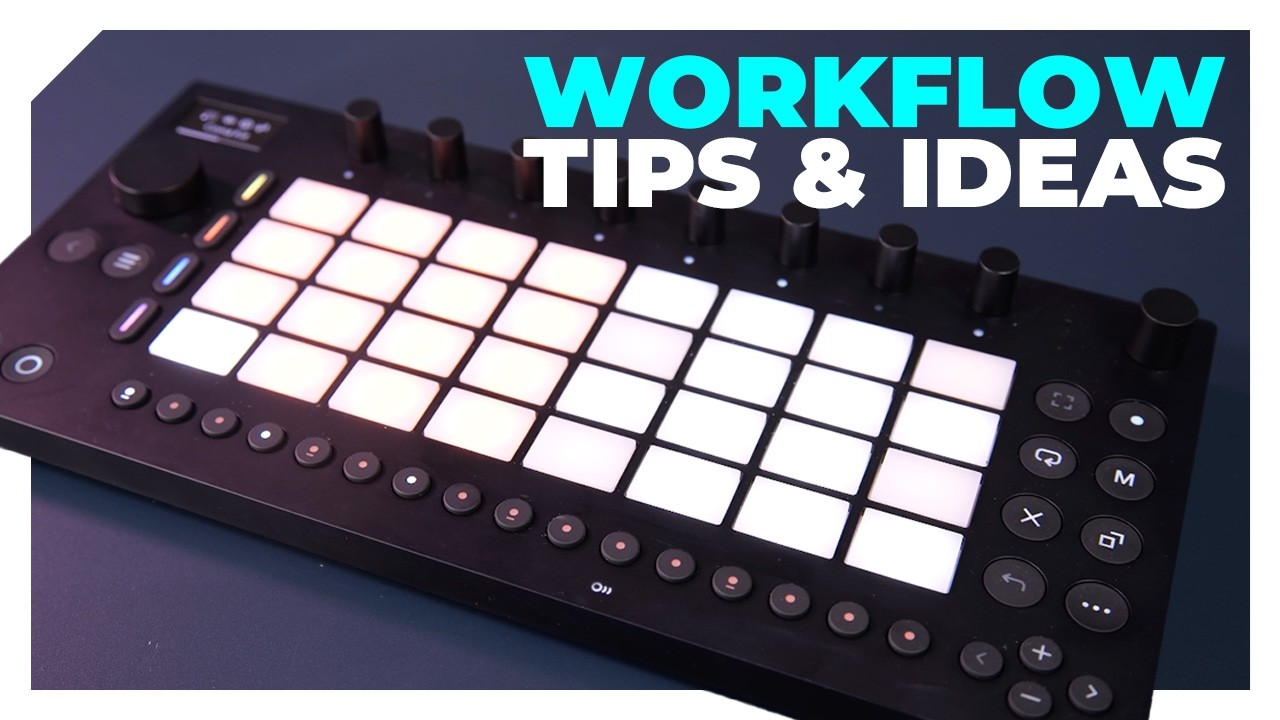When I reviewed Ableton’s compact {hardware} sketchpad Move final 12 months, I wrote that ‘for some, Move may show to be a gamechanger, however others will probably wrestle to suit it into their inventive workflow’. I need to admit that, initially a minimum of, I fell into the latter class.
On the (more and more uncommon) events I get to mess around with Live for non-work functions, it tends to contain processing easy sounds with Live’s extra sound design-focused gadgets, similar to its Hybrid Reverb, the pair of Spectral results or Roar’s multi-stage distortion/delay. Move, which is extra geared in direction of composing than sound design, doesn’t essentially match into that means of working.
I’ve all the time been impressed by Move’s capabilities on the subject of sketching out tough concepts, and I recognize how it may be used to rapidly tough out the fundamental components of a monitor. It simply doesn’t essentially lend itself to the kind of music I prefer to make.
In current weeks, nonetheless, I’ve picked Move again up, and one thing has lastly clicked. This is, partly, because of a run of firmware updates which have added a handful of intriguing new options since Move was first launched. (Updating our authentic assessment in mild of those was my preliminary cause for revisiting the {hardware}).
It’s additionally a results of embracing an altogether looser and extra haphazard means of utilizing the machine, which has helped to discover a genuinely helpful and galvanizing method to match it into my inventive workflow. But extra on that later…
On the Move
When Ableton Move was revealed in 2024, it excited loads of Live customers however confounded others. On the floor Ableton’s new {hardware} machine appeared rather a lot like a micro model of Push, however these anticipating an easy compact controller had been probably left confused by the assorted issues Move each might and couldn’t do.
Move is concurrently extra succesful and extra area of interest than one may count on from first look. Although it has the look of a easy controller or sequencer, Move’s onboard processor and bespoke OS enable it to behave as a self-contained groovebox, stocked with synths, drum kits and sampled devices, full with quite a lot of results and able to each sampling and resampling.
For all that it may possibly do, nonetheless, there are a selection of limitations on what Move is able to in comparison with Push 3. Whereas Push, in each controller and standalone modes, goals to supply as full a recreation of the desktop Live expertise as potential, Move makes use of only a small collection of Live’s instrument and impact gadgets and generally limits these to utilizing presets and a collection of pre-configured macro controls.
For probably the most half, these limitations are intentional and type of the entire level of Move. As an instrument, it’s pitched as a sketchpad greater than anything – a software designed to create beats and patterns that may be additional developed in its companion DAW. It purposely foregoes the bells and whistles required to create completed preparations or construct stay performances.
In follow, working round these limitations may be one of the vital inventive and galvanizing features of Move’s workflow. The restricted monitor rely, for instance, encourages the usage of the instrument’s resampling performance. By bouncing synth or bass riffs right down to slots in a Drum Rack, it is potential to concurrently unlock tracks for added melodic layers in addition to open up new methods to govern your resampled loops through the results in Move’s Drum Sampler.
Drum Sampler is certainly one of a handful of recent or upgraded Live gadgets which have emerged since Move was first unveiled which have clearly been designed with its workflow in thoughts. It’s extra simplistic than Live’s Simpler and Sampler gadgets, which makes it ideally suited for Move’s management floor, but additionally opens up new inventive instruments with its multifunctional impact slot, which gives on-the-fly looping, stretching, ring modulation and different fascinating methods to course of one-shot samples.
Similarly nicely suited is the up to date Auto Filter, which provides new inventive modes together with comb and vowel filters together with a revamped management structure. Auto Filter’s introduction to Move’s toolkit could be very welcome as its multifunctional LFO helps to deal with the instrument’s slight lack of modulation sources by offering a fast and straightforward answer for maintaining sounds shifting.





It bodes nicely for Move house owners that Ableton is exhibiting an ongoing dedication to unifying the workflow between Move, Note, Push and Live. Both Drum Sampler and Auto Filter are Device highlights throughout all of those platforms, and their inclusion helps Move really feel much less like a ‘mild’ model of the Live toolset, and extra like one particularly focused on the DAW’s most instant inventive instruments.
Thanks to a daily circulation of firmware updates, Move itself has additionally been improved in quite a few methods because it first hit the market. Move’s newest firmware is model 1.6, with v1.7 in beta, and every ‘level’ improve has introduced enhancements that make the {hardware} barely extra helpful in a day-to-day studio context.
Aside from the introduction of Auto Filter, nearly all of these enhancements have targeted on methods through which Move can pattern from or work together with different gadgets. Move can now, for instance, pattern audio through its USB-C enter, which is nice for recording instantly from a laptop computer or cell machine (though you’ll nonetheless want an adapter in case you’re utilizing a Lightning-equipped iPhone).
Ableton has additionally considerably upgraded Move’s MIDI choices, permitting every of its 4 tracks to each enter and output MIDI concurrently on a particular channel. Move also can now obtain MIDI clock from an exterior supply, in addition to output MIDI clock similtaneously receiving MIDI notes.
The different main enchancment, launched this summer season, is the flexibility to slice a sampled loop into up-to 16 sections. This is a handbook course of, which slices a loop in equal chunks by default and requires the customers to manually transfer slice factors to regulate these divisions, versus robotically inserting slice factors on transients, as in Live itself.




Watch On
Neither pattern slicing or the MIDI upgrades radically overhaul what Move is able to, and in each instances there are opponents available on the market which might be extra succesful. For devoted sampling, as an example, Move isn’t a patch on Roland’s similarly-priced SP-404.
Similarly, as a lot as Move’s MIDI capabilities are useful, it nonetheless lacks devoted MIDI ports. This means all MIDI communication wants to return via the USB port, which in some instances would require use of an adapter or hub.
The level, nonetheless, is that Move shouldn’t be a devoted sampler or a {hardware} sequencer – it’s an adjunct for Ableton Live, one designed to generate concepts and complement the workflow of the DAW. And every of those upgrades makes it a bit extra helpful on that entrance.
Rediscovering Move
Move’s biggest asset, by far, is the simplicity of transferring sounds and concepts created with the {hardware} to Live. By utilizing Ableton Cloud or the Move Manager, it takes seconds to wirelessly transfer Sets from one place to the opposite.
It’s embracing this facet of Move that has lastly made me see how helpful it may be. When I’ve tried to create complete-sounding beats or loops, I have a tendency to finish up with issues that I’m not significantly impressed by, however as a conduit for merely amassing ‘issues’ to switch to Ableton Live, it’s endlessly helpful.
For instance, within the strategy of reviewing new gear, I’m fortunate sufficient to get my fingers on an ever revolving line-up of recent synths and drum machines. I’ll now commonly use Move to pattern brief snatches of sound from no matter I’ve at hand.
I would construct a Drum Rack with my favorite one photographs from a drum machine, or file synth arps and sequences as loops, maybe slicing these to a Drum Rack too with the intention to resequence them later. I’ve a complete Move Set devoted to sampled chord stabs from numerous {hardware} synths.
Sounds, not music
In the previous, once I’ve sat down with Move, I’ve all the time felt inclined to attempt to make correct music with it. Not essentially an try at a completed monitor, however a completely fledged beat full with bassline and melodic components, and it is in doing this that it inevitably leads me in a path that I’m much less fascinated about.
Now, I hardly ever use Move itself to edit or organize issues – past, maybe, throwing a easy kick drum beneath a synth riff or creating a fast rhythm from one-shot samples. But capturing these uncooked sounds and easy motifs rapidly creates a wealthy pool of inspiration that’s available the following time I sit down at Live itself.








Essentially, by stopping trying to make correct music with Move, I’ve come to totally recognize its potential as a platform for half-formed concepts and barely-there sketches. Move is now, for me a minimum of, a unbelievable platform for amassing ‘issues’ fully indifferent from musical context – random chords I just like the sound of, easy rhythmic patterns, odd percussive sounds captured through the onboard mic.
While none of Move’s current updates have precisely altered its means for use on this means – it’s been potential to pattern and retailer sounds since day one – every iteration provides a bit extra flexibility, must you wish to, say, sequence a fast riff on an exterior synth, pattern a sound from YouTube through USB-C, slice a synth sequence or reverse one-shot sounds in a drum equipment.
Move’s newest replace, at present in beta, opens up full entry to Live’s Drift synth, which provides extra routes to potential inspiration. Now, Move can be utilized to design synth sounds from scratch on the go. What’s extra although, because of its beautiful expressive pads, it makes the machine an efficient compact instrument in its personal proper – a mini synth that it’s potential to play with stunning expressivity.
One 12 months on, Ableton’s dedication to opening up new ways in which Move can be utilized has, for me a minimum of, helped flip the machine from a neat curiosity into the genuinely helpful accent it was all the time pitched as.



